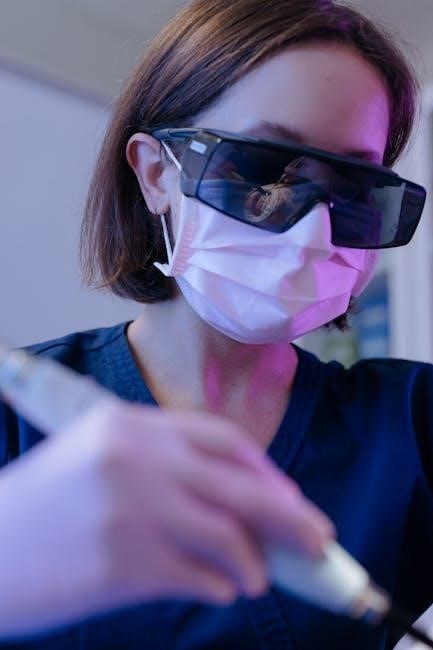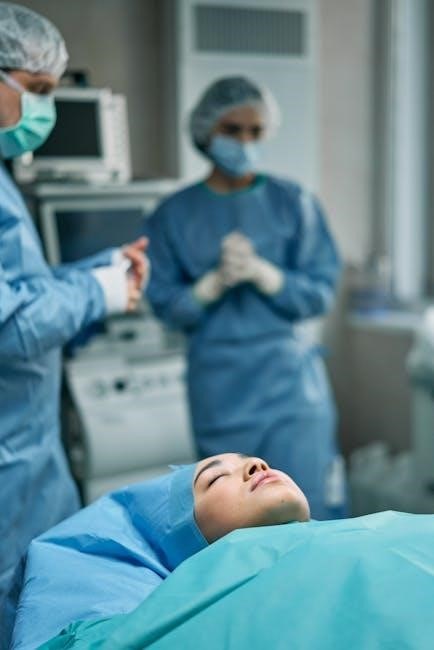Immediate Post-Operative Care
After LASIK surgery‚ rest with your eyes closed for 2-4 hours․ Avoid rubbing your eyes and keep them moist with prescribed drops․ Use protective eyewear at night to prevent accidental trauma․
- Avoid exposing your eyes to water or moisture for the first week․
- Wear protective eyewear‚ especially at night‚ to prevent eye injuries․
- Avoid strenuous activities and ensure your eyes remain clean and dry․
Follow your surgeon’s instructions carefully to promote healing and minimize complications․
1․1․ Protecting the Eyes
After LASIK‚ avoid rubbing your eyes to prevent dislodging the corneal flap․ Use protective eyewear‚ especially at night‚ to avoid accidental trauma․ Keep your eyes moist with prescribed drops and avoid exposing them to irritants like dust or chemicals during the initial healing phase․
1․2․ Avoiding Water and Moisture
Keep your eyes dry for the first week post-LASIK to prevent infection․ Avoid swimming‚ hot tubs‚ and water sports․ When washing your face‚ keep water out of your eyes; Use a clean‚ damp cloth to gently wipe around them without touching the surgical area․
- Avoid direct exposure to water during showers or baths․
- Do not swim with your eyes open underwater for two weeks․
1․3․ Using Protective Eyewear
Wear protective eyewear‚ especially at night‚ to prevent accidental eye injuries․ Use non-prescription protective glasses during the day to shield your eyes from dust and debris․ This ensures the corneal flap remains undisturbed‚ promoting proper healing and reducing the risk of complications․
Managing Discomfort and Dryness
After LASIK‚ expect mild discomfort and dryness․ Use prescribed eye drops to lubricate and soothe your eyes․ Avoid rubbing to prevent dislodging the corneal flap․
2․1․ Using Prescribed Eye Drops
Use prescribed antibiotic and steroid eye drops as directed to prevent infection and reduce inflammation․ Gently pull your lower eyelid‚ tilt your head‚ and place one drop in the corner of each eye․ Avoid touching the bottle tip to your eye․ Use drops for the prescribed duration‚ usually several weeks‚ to ensure proper healing and minimize dryness․ Follow the schedule provided by your surgeon to maintain eye health and prevent complications․
2․2․ Dealing with Dry Eyes
Dry eyes are common post-LASIK․ Use artificial tears frequently to lubricate your eyes and reduce discomfort․ Avoid rubbing your eyes‚ as this can worsen dryness․ Blinking exercises and using a humidifier may help․ If dryness persists‚ consult your surgeon for additional solutions․
2․3․ Avoiding Rubbing the Eyes
Avoiding eye rubbing is crucial after LASIK to prevent dislodging the corneal flap․ Rubbing can cause complications like flap displacement or infection․ Use artificial tears to soothe dryness and wear protective eyewear at night to reduce the urge to rub during sleep․ Follow your surgeon’s advice to ensure proper healing and prevent setbacks․

Visual Recovery and Expectations
Vision typically improves within days‚ with clarity refining over weeks․ Blurry vision and halos may occur initially but usually subside․ Full recovery can take up to 6 months․
3․1․ Timeline for Vision Improvement
Vision often improves immediately‚ with significant clarity within a few days․ Most patients see well by the first week‚ though sharpness and clarity may take 1-3 months․ Some may experience vision fluctuations‚ but full stabilization typically occurs by 6 months post-surgery;
3․2․ Understanding Vision Fluctuations
Vision fluctuations are common after LASIK‚ with clarity varying during the healing process․ Blurry vision and halos may occur‚ especially at night․ These typically improve as the cornea heals․ Most fluctuations stabilize within 1-3 months‚ but some patients may experience minor changes for up to 6 months․
3․3․ Blurry Vision and Halos
Blurry vision and halos around lights are common after LASIK‚ caused by the healing corneal flap and temporary dryness․ These symptoms usually improve within a few weeks but may persist in rare cases․ Most patients see significant improvement by 1-3 months‚ with halos diminishing over time․

Safe Activities Post-Surgery
Resume non-strenuous activities like reading or desk work within a day․ Avoid swimming‚ makeup‚ and dusty environments for two weeks to protect your eyes during healing․
- Avoid contact sports and heavy lifting for 4-6 weeks․
- Wear protective eyewear during physical activities to prevent injury․
4․1․ Returning to Work or School
You can typically return to work or school within 1-3 days after LASIK surgery․ However‚ you may experience blurry vision or sensitivity to light initially․ Avoid activities involving chemicals‚ makeup‚ or dusty environments for the first week to ensure proper healing․
- Most patients resume daily routines within a few days․
- Avoid eye makeup for 1-2 weeks to reduce infection risk․
4․2․ Resuming Exercise and Physical Activity
Avoid strenuous activities‚ bending‚ or heavy lifting for 1-2 weeks post-surgery․ Light exercise‚ like walking‚ may resume after 3-4 days․ Avoid swimming‚ contact sports‚ or activities that risk eye trauma for 4-6 weeks to ensure proper healing and minimize complications․
- Avoid activities that could expose eyes to dust or debris․
- Protective eyewear is recommended during physical activity․
4․3․ Avoiding Swimming and Water Sports
Avoid swimming‚ hot tubs‚ and water sports for 2-4 weeks post-surgery․ Water exposure increases infection risks and can dislodge the corneal flap․ When swimming resumes‚ wear protective goggles to prevent eye contamination․
- Submerging eyes underwater can introduce bacteria․
- Chlorine and chemicals in water may irritate eyes․
Follow-Up Care and Monitoring
Schedule post-operative check-ups within 24-48 hours and at regular intervals for the first six months․ These visits monitor healing progress and address potential complications promptly․
- Attend all follow-up appointments to ensure proper recovery․
5․1․ Schedule of Post-Operative Check-Ups
Regular follow-up appointments are crucial for monitoring healing․ Schedule check-ups within 24-48 hours post-surgery‚ then at 1 week‚ 1 month‚ and 3-6 months․ These visits ensure proper recovery and address any concerns promptly․
- First visit: 1-2 days post-op for initial healing assessment․
- Subsequent visits: weekly‚ monthly‚ and up to 6 months as needed․
5․2․ Important Signs to Watch For
Monitor for increased redness‚ unusual pain‚ or vision changes․ These could indicate complications like infection or dry eye syndrome․
- Severe eye pain or persistent discomfort
- Flashes of light or new floaters
- Double vision or significant vision loss
Seek immediate medical attention if these symptoms occur to prevent serious issues․
5․3․ Communicating with Your Surgeon
Maintain open communication with your surgeon․ Contact them immediately if you experience severe symptoms or concerns․ Attend all scheduled follow-up appointments․ Use these visits to ask questions and ensure proper healing․
- Ask about medication usage and any changes․
- Clarify activity restrictions and timelines․
- Discuss any vision changes or concerns․
Common Complications and Solutions
Common post-LASIK complications include dry eyes‚ undercorrection‚ or corneal flap issues․ Solutions may involve additional procedures‚ medications‚ or extended recovery time to address these concerns effectively․
- Dry eyes may require prolonged artificial tear use․
- Undercorrection can sometimes be treated with enhancement surgery․
- Corneal flap issues may need medical intervention․
6․1․ Infection Prevention and Treatment
Infection risk is low but serious․ Use prescribed antibiotic drops as directed to minimize risk․ Avoid contaminated water‚ makeup‚ or sharing products․ If signs of infection appear‚ such as redness or discharge‚ contact your surgeon immediately for treatment․
- Follow strict hygiene practices․
- Avoid touching your eyes unnecessarily․
6․2․ Managing Undercorrection or Overcorrection
Undercorrection or overcorrection may occur‚ causing persistent refractive errors․ Monitor vision changes and attend follow-ups․ If needed‚ enhancement surgeries or corrective treatments can address these issues․ Discuss with your surgeon for tailored solutions to achieve optimal vision outcomes․
- Use prescribed eye drops to aid healing and clarity․
- Report any persistent vision issues promptly․
6․3․ Dealing with Corneal Flap Issues
Corneal flap complications‚ such as dislocation or inflammation‚ require immediate attention․ Avoid water contact and trauma to the eyes․ Use protective eyewear and adhere to prescribed medications․ Attend follow-up appointments to monitor healing and address any flap-related concerns promptly․
- Avoid rubbing your eyes to prevent flap displacement․
- Report any unusual pain or vision changes to your surgeon․
Lifestyle Adjustments for Recovery
Avoid makeup‚ chemicals‚ and UV exposure to protect your eyes․ Wear sunglasses outdoors and maintain a healthy diet rich in vitamins A and C to support healing and overall eye health․
- Avoid makeup and chemicals to prevent infection and irritation․
- Protect your eyes from UV light with sunglasses․
- Eat a balanced diet to promote recovery and eye health․
7․1․ Avoiding Makeup and Chemicals
Refrain from using eye makeup‚ lotions‚ and chemicals for at least two weeks post-surgery․ These can contaminate the eyes and delay healing․ Avoid sharing makeup and ensure all products are clean when reintroducing them to your routine․
- Avoid eye makeup for two weeks to prevent infection․
- Keep makeup and skincare products clean and separate․
- Delay using lotions or chemicals near the eyes until healed․
7․2․ Protecting Eyes from UV Light
Wear sunglasses with UV 400 protection outdoors to shield your eyes from harmful rays․ This is crucial during the healing process to prevent photophobia and promote recovery․ Choose wraparound styles for maximum coverage․
- Use sunglasses with UV 400 protection when outdoors․
- Opt for wraparound styles to block peripheral light․
- Apply UV protection even on cloudy days․
7․3․ Maintaining a Healthy Diet
A balanced diet rich in vitamins A‚ C‚ and E supports healing and eye health․ Include leafy greens‚ citrus fruits‚ and omega-3 fatty acids․ Stay hydrated to prevent dry eyes and avoid processed foods that may slow recovery․
- Incorporate foods high in antioxidants like berries and nuts․
- Drink plenty of water to maintain eye moisture․
- Limit sugary and processed foods to promote healing․
Long-Term Care and Maintenance
To maintain eye health‚ schedule regular check-ups and monitor for any vision changes․ Wear UV-protective sunglasses and stay hydrated to prevent dry eyes․ Maintain a healthy diet rich in antioxidants to support eye health․
- Schedule regular follow-up appointments with your eye doctor․
- Monitor for any changes in vision or eye comfort․
- Protect your eyes from UV light with sunglasses․
- Stay hydrated to help prevent dry eyes․
- Maintain a healthy lifestyle to support overall eye health․
8․1․ Ongoing Eye Health Monitoring
Regular follow-ups with your eye doctor are crucial to monitor healing progress and detect any potential issues early․ Attend scheduled appointments and report any vision changes or discomfort promptly to ensure optimal eye health and address concerns before they escalate․
- Schedule regular check-ups as recommended by your surgeon․
- Monitor for signs of complications‚ such as vision changes or eye pain․
- Continue using prescribed eye drops if advised to maintain eye health․
8․2․ Preventing Dry Eye Syndrome
Use artificial tears regularly to lubricate your eyes and prevent dryness․ Avoid prolonged screen time and stay hydrated to support tear production․ Blinking exercises can also help maintain eye moisture and reduce discomfort after LASIK surgery․
- Use preservative-free artificial tears as directed by your surgeon․
- Avoid exposure to dry environments or irritants like smoke․
- Incorporate blinking exercises into your daily routine to stimulate tear production․
8․3․ Avoiding Smoking and Secondhand Smoke
Avoid smoking and secondhand smoke to prevent eye irritation and promote healing․ Smoking can slow recovery and increase the risk of complications․ Quitting or avoiding smoke exposure is crucial for maintaining eye health after LASIK surgery․
- Quit smoking during the recovery period to reduce irritation risks․
- Stay away from environments with secondhand smoke to protect your eyes․
- Inform others to avoid smoking near you to ensure a smoke-free recovery environment․

Travel and Activity Restrictions
After LASIK‚ avoid air travel for 24-48 hours and exposure to dusty environments․ Refrain from swimming and water activities for two weeks to prevent complications and ensure proper healing․
9․1․ Avoiding Air Travel Too Soon
Patients should avoid air travel for 24-48 hours post-LASIK to prevent eye pressure changes and dryness․ Cabin pressure can dislodge the corneal flap‚ increasing complication risks․ Consult your surgeon for specific guidelines to ensure safe recovery and avoid unnecessary risks during the healing process․
9․2․ Limiting Exposure to Dust
Avoid dusty environments for the first week post-LASIK to reduce the risk of eye irritation and complications․ Use protective eyewear in dusty settings and keep windows closed to minimize exposure․ This helps prevent dryness and promotes a smooth recovery process․
- Wear protective eyewear in dusty areas․
- Keep your home clean and dust-free․
- Avoid activities like yard work or gardening during the initial healing phase․
9․3․ Avoiding Contact Sports
Refrain from contact sports for at least 4-6 weeks post-LASIK to prevent eye injury․ Wear protective eyewear if participation is unavoidable․ This precaution ensures the corneal flap heals properly‚ reducing the risk of complications or vision disturbances․
- Delay returning to boxing‚ wrestling‚ or martial arts․
- Use protective eyewear if sports participation is necessary․
- Consult your surgeon before resuming high-risk activities․
Emotional and Mental Well-Being
Focus on mental recovery by managing expectations and staying positive․ Seek support from family or counselors to cope with any stress related to vision changes․ Stay patient and celebrate small progress․
10․1․ Coping with Recovery Stress
Recovery stress is common post-LASIK․ Set realistic expectations and focus on gradual progress․ Lean on family and friends for emotional support․ Practice mindfulness or deep breathing to stay calm during the healing process․ Celebrate small improvements to maintain a positive mindset․
- Communicate openly with your surgeon about concerns․
- Engage in relaxing activities to reduce anxiety․
10․2․ Setting Realistic Expectations
Set realistic expectations for vision recovery post-LASIK․ Vision may be blurry initially but improves gradually․ Understand dryness or mild discomfort are temporary․ Follow your surgeon’s advice to avoid overexertion and ensure proper healing․
- Avoid expecting perfect vision immediately; recovery takes time․
- Understand that complete healing may require several months․
- Attend follow-ups to monitor progress and address concerns․
10․3․ Building a Support System
Having a strong support system aids recovery․ Ask a friend or family member to assist with daily tasks and accompany you to follow-ups․ Emotional support can ease stress and help you stay positive during the healing process․
- Ensure someone is available to help with errands and chores․
- Share your recovery plan with your support network for encouragement․
- Lean on loved ones for emotional support during downtime․
Medications and Supplements
Use prescribed antibiotic and steroid drops to promote healing and prevent infection․ Artificial tears can alleviate dry eyes․ Avoid non-prescription medications to prevent complications․
- Follow the exact dosage instructions for all medications․
- Do not share medications or use expired drops․

Returning to Normal Life
11․1․ Using Antibiotic and Steroid Drops
Use antibiotic drops to prevent infection and steroid drops to reduce inflammation․ Follow the prescribed dosage and duration․ Avoid stopping early‚ even if symptoms improve․ Do not share or use expired drops to ensure safety and effectiveness․
- Shake the bottle before use and avoid touching the dropper tip․
- Administer drops gently to avoid eye irritation․

Leave a Reply